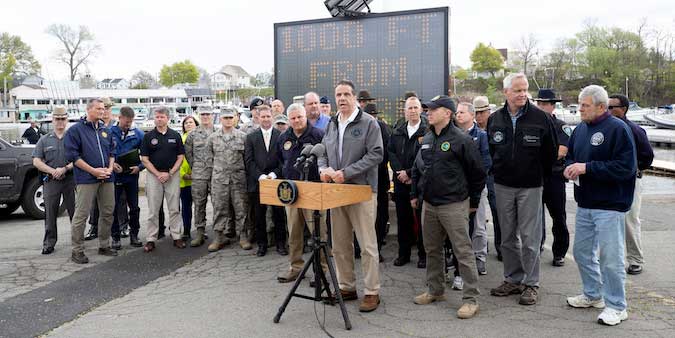Governor declares state of emergency for 8 counties as lake levels rise
Press Release/Governor’s Office
OLCOTT – Governor Cuomo today declared a State of Emergency for the eight counties impacted by potential Lake Ontario flooding: Cayuga, Jefferson, Monroe, Niagara, Orleans, Oswego, St. Lawrence and Wayne.
The governor’s order directs state agencies to protect state property and to assist local governments and individuals in responding to and recovering from the flooding. Additionally, the declaration helps state resources and assets assist on private property, including the further placement of flooding prevention barriers.
The governor also directed the Commissioner of the New York State Office of Parks, Recreation and Historic Preservation to implement a 5-mile per hour speed limit, where the commissioner finds it appropriate, to control wakes along the Lake Ontario shoreline in the affected counties as part of the state’s ongoing response to coastal flooding in the region.
Beginning today, vessels operating within 1,000 feet of shore, unless otherwise directed by a County Declaration, must observe a 5 mile per hour speed limit to reduce impacts to shoreline residences and infrastructure caused by wave action and to promote safe boating. The no wake zone does not apply to communities along the St. Lawrence River.
“We are preparing now for the reoccurrence of the 2017 flooding situation, which as people remember was devastating and caused a lot of damage and a lot of hardship for thousands of New Yorkers,” Cuomo said. “We’re talking about the entire shoreline of Lake Ontario, so it’s hundreds of miles of New York State property. The only course of action is to do everything we can to be prepared before the flooding actually happens – and that’s what we’re doing. I’m also declaring an emergency order for the affected communities that sets a maximum speed limit of 5 miles per hour 1,000 feet from shoreline because the last thing we need are boat wakes creating additional waves. The emergency order also gives us flexibility in dealing with local governments and private property so we can install AquaDam and other equipment to protect the shoreline.”
Under normal conditions, boaters are required to obey the 5 mile per hour speed limit within 100 feet of shore. With the current state of emergency in the region, and as water levels continue to rise throughout Lake Ontario, the governor is authorizing and directing State Parks to institute the expanded speed restriction to 1,000 feet in appropriate areas, unless otherwise directed by a County Declaration.
Waves created by boat wakes can exacerbate shoreline erosion, further threatening residential and municipal infrastructure. Reducing speeds will result in smaller boat wakes and lessen the wave action along the shore. Reduced speeds are also necessary to ensure safe boating, as many hidden hazards and debris have been covered by elevated water levels and can threaten boaters’ safety. State agencies are working with municipalities to educate boaters and have positioned digital message boards at strategic locations throughout the region.
In addition to the 200 New York National Guard activated by the Governor to assist with preparedness operations, 200 members of the New York National Guard are on standby for immediate deployment in the eight counties impacted by Lake Ontario flooding. To date, the State has deployed 20 sandbaggers, over one million empty sandbags and 560,000 filled sandbags, hundreds of pumps, and over 5,000 feet of AquaDam to the impacted regions.
In addition to the Division’s coordination efforts and deployment of resources the State Department of Environmental Conservation has issued a General Permit to address the potentially damaging effects of high water levels in Lake Ontario and the St. Lawrence River due to the ongoing above average precipitation and snow melt in the Great Lakes Basin. This permit, based on an Emergency Declaration issued by the DEC commissioner, will expedite the process for shoreline property owners to quickly make necessary repairs and stabilize their properties from flood damage. High water levels are projected to continue and may cause widespread shoreline erosion, damage coastline structures and jeopardize infrastructure similar to the historic flooding that took place in the spring of 2017.
The new permit is available on DEC’s website. DEC will accept applications through April 30, 2020. The General Permit authority is in effect until September 30, 2020.
Permitted activities include:
• Repair and in-kind replacement of erosion structures;
• Repair or in-kind reconstruction of existing public roads, bridges, utilities, and other public infrastructure;
• Stabilization of existing, functional storm-damaged dwellings, decks, and walkways with temporary bracing and piling; and
• Removal of channel blockages in tributaries to Lake Ontario blocked by shoreline sediment.
Homeowners and municipalities with questions about the permits can contact their Regional DEC Permit Administrator.
State Assemblyman Michael Norris, R-Lockport, issued this statement: “I commend Gov. Cuomo for his attention to the imminent and worsening situation on the southern shores of Lake Ontario. Declaring a State of Emergency increases the commitment of state resources to assist with potential flooding and erosion due to the extreme high water levels. It is vital that we protect our infrastructure, property owners and the investment of businesses and tourism in our communities.”






































































